

 Prescot Street (originally Great Prescot(t) Street)
Prescot Street (originally Great Prescot(t) Street)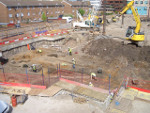 The
north side of Prescot Street was the site of an
archaeological evaluation in 2006 and a dig in 2008, prior to the building of a hotel [left, towards South Tenter Street] - see here for details,
including video diaries and material about the significance of the
site. It formed part of what is known as the East London Roman cemetery. In 1678 numerous Roman funeral urns
and lachrymatories, with bars and
silver money had been found here. It
may have been linked with the sixth legion of the Roman army, for in
1787 a stone 15" x 12" x3" was found with the inscription [right]: The
north side of Prescot Street was the site of an
archaeological evaluation in 2006 and a dig in 2008, prior to the building of a hotel [left, towards South Tenter Street] - see here for details,
including video diaries and material about the significance of the
site. It formed part of what is known as the East London Roman cemetery. In 1678 numerous Roman funeral urns
and lachrymatories, with bars and
silver money had been found here. It
may have been linked with the sixth legion of the Roman army, for in
1787 a stone 15" x 12" x3" was found with the inscription [right]:Ditches, three burials and a range of pits were uncovered, together with some glass (described in vol.12 of the London Archaeologist). Several 15th century pits were recorded, including a rubbish pit 10m across with leather and other organic remains, inlucing 'poulaine' shoes and leatherworking waste. Later remains dated from the 18th century housing development. |
D M
FL AGICoLA. MIL. LEG. VI. VICT. V. AN. XLII. VI. D. X. ALBIA. FAUSTINA. CoNIVGi INCoNPARABILI F C |
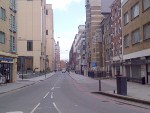



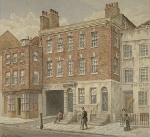 As it was developed for good-quality housing, it became
one of the earliest
London streets to have numbered buildings, rather than signs (from
1708) - perhaps copying the practice of the staircases of the Inns of
Court. An early resident, before he moved to Soho Square, was the
'rough old admiral' Sir Cloudesley Shovel. The current Pevsner characterises the street today [left, looking west] as ragged with insignificant commercial permises and flashy offices muscling in on older fabric. As noted below, a number of buildings (including some since demolished) were listed at Grade 2 in 1973. Also left are two distinctive bollards from the street (see here for a comprehensive website on London street bollards); right are Victorian watercolours of the front and rear of no.43.
As it was developed for good-quality housing, it became
one of the earliest
London streets to have numbered buildings, rather than signs (from
1708) - perhaps copying the practice of the staircases of the Inns of
Court. An early resident, before he moved to Soho Square, was the
'rough old admiral' Sir Cloudesley Shovel. The current Pevsner characterises the street today [left, looking west] as ragged with insignificant commercial permises and flashy offices muscling in on older fabric. As noted below, a number of buildings (including some since demolished) were listed at Grade 2 in 1973. Also left are two distinctive bollards from the street (see here for a comprehensive website on London street bollards); right are Victorian watercolours of the front and rear of no.43. 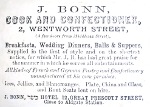
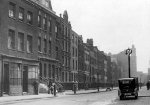
 From around 1870-90 there was a synagogue in
the street, and from 1857-80 the Jewish Widows' Home Asylum was at no.67 before
moving to Hackney. In the early 20th century the Association for the
Protection of Women and Girls ran a refuge for young girls arriving in
London and at risk from pimps and procurers. See above and here for more details of Jewish welfare agencies in the area. Bonn's Kosher Hotel was at no.12 - left is a lavish wedding menu of 1892. Bonn's Matzos was taken over by Rakusens in the 1970s (more details here). Right is Prescot Street in 1935, looking eastwards.
From around 1870-90 there was a synagogue in
the street, and from 1857-80 the Jewish Widows' Home Asylum was at no.67 before
moving to Hackney. In the early 20th century the Association for the
Protection of Women and Girls ran a refuge for young girls arriving in
London and at risk from pimps and procurers. See above and here for more details of Jewish welfare agencies in the area. Bonn's Kosher Hotel was at no.12 - left is a lavish wedding menu of 1892. Bonn's Matzos was taken over by Rakusens in the 1970s (more details here). Right is Prescot Street in 1935, looking eastwards. 
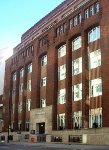

 Nos.1 & 9 were developed in Art Deco [Pevnser specifies 'Amsterdam School'] style in the 1930-33 by L.G. Ekins, architect of the
Co-operative Wholesale Society [on which see below], and used by the
Co-op Bank; they are
Grade 2 listed buildings. J.C. Blair's carving over the doorway of
no.1
symbolises CWS principles - two individuals shaking hands beneath a
hive of bees where the bees gain benefits from mutual co-operation [see below on the wheatsheaf, another Co-op symbol]. Formerly offices, in
1999 no.1 was converted into 150 luxury flats (winning awards).
In July 2008 some corporate directorates of Barts and the London moved
into no.9 (103,500 sq ft) - bringing them full circle. Other CWS headquarters in Leman Street are described below.
Nos.1 & 9 were developed in Art Deco [Pevnser specifies 'Amsterdam School'] style in the 1930-33 by L.G. Ekins, architect of the
Co-operative Wholesale Society [on which see below], and used by the
Co-op Bank; they are
Grade 2 listed buildings. J.C. Blair's carving over the doorway of
no.1
symbolises CWS principles - two individuals shaking hands beneath a
hive of bees where the bees gain benefits from mutual co-operation [see below on the wheatsheaf, another Co-op symbol]. Formerly offices, in
1999 no.1 was converted into 150 luxury flats (winning awards).
In July 2008 some corporate directorates of Barts and the London moved
into no.9 (103,500 sq ft) - bringing them full circle. Other CWS headquarters in Leman Street are described below. 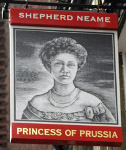
 No.15 [right] is the neat and narrow [Pevsner] Princess of Prussia public house, built around 1880. Princess Anna Amalia (1723-87) was a gifted musician, whose sister married the Crown Prince of Sweden.
No.15 [right] is the neat and narrow [Pevsner] Princess of Prussia public house, built around 1880. Princess Anna Amalia (1723-87) was a gifted musician, whose sister married the Crown Prince of Sweden.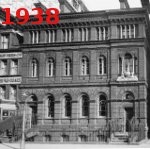
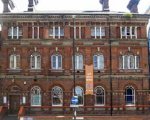
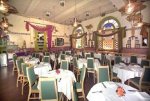 Next door, at no.16,
was
Whitechapel County Court, a 4-storey Italianate building, modelled on a Florentine or Pisan town house or small palace, with arched windows, detached columns and a heavy dentil cornice, designed in
1857-8
by Charles Reeves & Lewis G. Butcher (showing an early
Ruskin influence): Reeves was the surveyor of county courts, and some
of his drawings are at the National Archives. It combines features of
19th century police stations
with those of commercial and industrial Victorian buildings; it was
listed in 1973. (See here for the history of magistrates' courts in the area.) After the court moved, it was used as government
offices, and is now the acclaimed Café Spice Namasté with a noted Parsi chef from Goa, Cyrus Todiwala OBE, who makes regular tv appearances. [Building left in 1938 and today, plus interior].
Next door, at no.16,
was
Whitechapel County Court, a 4-storey Italianate building, modelled on a Florentine or Pisan town house or small palace, with arched windows, detached columns and a heavy dentil cornice, designed in
1857-8
by Charles Reeves & Lewis G. Butcher (showing an early
Ruskin influence): Reeves was the surveyor of county courts, and some
of his drawings are at the National Archives. It combines features of
19th century police stations
with those of commercial and industrial Victorian buildings; it was
listed in 1973. (See here for the history of magistrates' courts in the area.) After the court moved, it was used as government
offices, and is now the acclaimed Café Spice Namasté with a noted Parsi chef from Goa, Cyrus Todiwala OBE, who makes regular tv appearances. [Building left in 1938 and today, plus interior].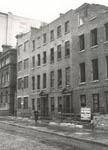
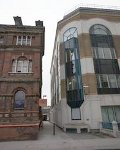 No.21 (and adjacent properties) was the site of the 24-bed London
Infirmary
for sick and diseased manufacturers, seamen in the merchant service
and their wives and families from 1741. The house was rented from Sir
William Leman at 24 guineas a year; it expanded to five houses, and
included a mortuary, a herb garret (for drying and storing medicinal
herbs) and a cold bath (since its first physician was a devotee of
therapeutic bathing). In 1757 it moved to its present site at Mount
Field, Whitechapel Road as the London Hospital. (The excellent Barts
and The London
website provides much more detail about this and other hospital sites, and there is
an fascinating museum at the former St Philip's Church, Newark Street
behind the main hospital buildings.) The
Prescot Street site was then let in 1758 to the Magdalen Hospital
on a 7-year lease. (Magdalen Passage, running through its former site - right - is a reminder.)
No.21 (and adjacent properties) was the site of the 24-bed London
Infirmary
for sick and diseased manufacturers, seamen in the merchant service
and their wives and families from 1741. The house was rented from Sir
William Leman at 24 guineas a year; it expanded to five houses, and
included a mortuary, a herb garret (for drying and storing medicinal
herbs) and a cold bath (since its first physician was a devotee of
therapeutic bathing). In 1757 it moved to its present site at Mount
Field, Whitechapel Road as the London Hospital. (The excellent Barts
and The London
website provides much more detail about this and other hospital sites, and there is
an fascinating museum at the former St Philip's Church, Newark Street
behind the main hospital buildings.) The
Prescot Street site was then let in 1758 to the Magdalen Hospital
on a 7-year lease. (Magdalen Passage, running through its former site - right - is a reminder.)  Damaged in the Blitz, the buildings stood derelict until the 1970s,
when they were demolished to make way for the present structure, built
in 1988 with 50,000 ft² of office space on six floors for Abbey
National Bank, later Santander - it became a call centre for 600 staff.
Their lease expired on 24 December 2012, and the freehold was acquired
by the Royal College of Psychiatrists
which, having outgrown 17 Belgrave Square in the West End and already
running some of its activities in East London (including Standon House, 21 Mansell Street), needed premises to bring all
its work together on one site. They moved onto the site in the autumn of 2013 - details here - and we welcome them and wish them well in their new home!
Damaged in the Blitz, the buildings stood derelict until the 1970s,
when they were demolished to make way for the present structure, built
in 1988 with 50,000 ft² of office space on six floors for Abbey
National Bank, later Santander - it became a call centre for 600 staff.
Their lease expired on 24 December 2012, and the freehold was acquired
by the Royal College of Psychiatrists
which, having outgrown 17 Belgrave Square in the West End and already
running some of its activities in East London (including Standon House, 21 Mansell Street), needed premises to bring all
its work together on one site. They moved onto the site in the autumn of 2013 - details here - and we welcome them and wish them well in their new home!

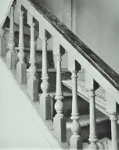 The houses at nos. 23, 24, 25 and 30 were listed Grade II in 1973. No.23,
a 4-storey plus basement yellow brick house with a handsome doorcase, railings and steps, is the only
survivor of the 1770s redevelopment of the Leman estate; no.30
is from the early 19th century (staircase left).
The houses at nos. 23, 24, 25 and 30 were listed Grade II in 1973. No.23,
a 4-storey plus basement yellow brick house with a handsome doorcase, railings and steps, is the only
survivor of the 1770s redevelopment of the Leman estate; no.30
is from the early 19th century (staircase left).
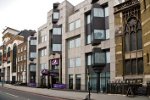
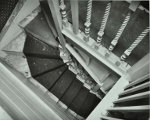
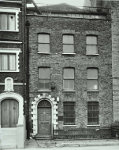
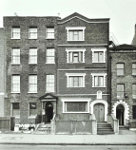 No.24 was a Victorian Tudor house, and
had been the Convent of Mary Immaculate (shown in 1969, next to no.23); no.25, with rounded doorframe, was next door (stairwell right). Both were demolished, and
replaced by a block built as Juno Court, 24-26 (far right - brashly unpleasant, says Pevsner), which is now London City Premier Inn.The sisters remain active in the area.
No.24 was a Victorian Tudor house, and
had been the Convent of Mary Immaculate (shown in 1969, next to no.23); no.25, with rounded doorframe, was next door (stairwell right). Both were demolished, and
replaced by a block built as Juno Court, 24-26 (far right - brashly unpleasant, says Pevsner), which is now London City Premier Inn.The sisters remain active in the area.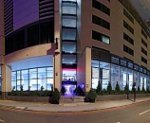
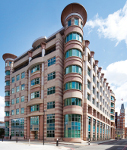 No.46 is the 5-star Grange Tower Bridge Hotel [left].
No.46 is the 5-star Grange Tower Bridge Hotel [left].| March 10 - A terrible fire broke out in the night at a cooperage, in Rosemary-branch-alley, Rosemary-lane, which consumed the whole of the premises, and also Branch's cloaths exchange, consisting of about 12 houses, chiefly built of wood, and inhabited by piece-brokers. The fire raged with great furyfor more than one hours, through the want of water. Happily no lives were lost. |
 Piece brokers were dealers in cloth, especially remnants. The
elegantly-inscribed registers of St Botolph Aldgate record children and
young people (some from workhouses) for whom they arranged apprenticeships,
including Mary Ann
Evans, aged 14, placed in 1805 with Elizabeth Dishington, widow of 4
Rosemary Branch Alley, as a piece broker till 21 or day of Marriage, for a
fee of £2 plus a further £2 2s at the Expiration of Six Weeks from the date of the Indenture.
Piece brokers were dealers in cloth, especially remnants. The
elegantly-inscribed registers of St Botolph Aldgate record children and
young people (some from workhouses) for whom they arranged apprenticeships,
including Mary Ann
Evans, aged 14, placed in 1805 with Elizabeth Dishington, widow of 4
Rosemary Branch Alley, as a piece broker till 21 or day of Marriage, for a
fee of £2 plus a further £2 2s at the Expiration of Six Weeks from the date of the Indenture.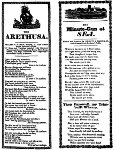
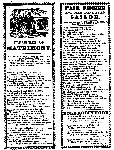
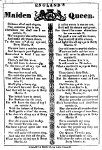
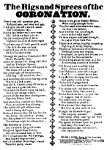


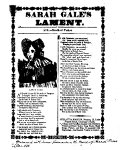
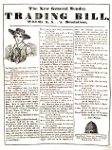 Hillatt & Martin, printers at no.13, were publishers of broadside ballads in the first half of the 19th century, and some examples are shown here: nautical songs, such as The Arethusa, The Minute Gun at Sea, Then farewell, my trim-built wherry and Phoebe and her dark-eyed sailor; bawdy songs about Queen Victoria's coronation - The Maiden Queen and Rigs & Sprees of the Coronation (1837); tragi-comic ditties, some in 'Cockney dialect' replacing 'v' with 'w' and adding/subtracting the letter 'h', such as All round my hat (to the tune 'Poor little Fisherman's Boy'), Poll and my partner Joe, Pleasures of Matrimony, and the curious Sarah Gale's Lament (to the tune 'Death of Parker'), concerned with James Greenacre in the Murder of Hannah Brown (December 1856).
In 1855 they distributed a skit (song plus text) on The New General Sunday Trading Bill, with Sir A. A....'s resolutions. (This bill, to restrict Sunday trading, was introduced by Lord Grosvenor, and occasioned riots in Hyde Park; 'Sir A.A' was Sir Andrew Agnew, a Sabbatarian with whom Charles Dickens crossed swords.)
Hillatt & Martin, printers at no.13, were publishers of broadside ballads in the first half of the 19th century, and some examples are shown here: nautical songs, such as The Arethusa, The Minute Gun at Sea, Then farewell, my trim-built wherry and Phoebe and her dark-eyed sailor; bawdy songs about Queen Victoria's coronation - The Maiden Queen and Rigs & Sprees of the Coronation (1837); tragi-comic ditties, some in 'Cockney dialect' replacing 'v' with 'w' and adding/subtracting the letter 'h', such as All round my hat (to the tune 'Poor little Fisherman's Boy'), Poll and my partner Joe, Pleasures of Matrimony, and the curious Sarah Gale's Lament (to the tune 'Death of Parker'), concerned with James Greenacre in the Murder of Hannah Brown (December 1856).
In 1855 they distributed a skit (song plus text) on The New General Sunday Trading Bill, with Sir A. A....'s resolutions. (This bill, to restrict Sunday trading, was introduced by Lord Grosvenor, and occasioned riots in Hyde Park; 'Sir A.A' was Sir Andrew Agnew, a Sabbatarian with whom Charles Dickens crossed swords.) 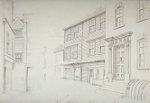 Right is a drawing, c1880, by John Philipps Emslie, of 7, 6 and 5
Little Prescot Street, backing onto Royal Mint Street, showing that a
few wooden houses remained, as well as grander properties.
Right is a drawing, c1880, by John Philipps Emslie, of 7, 6 and 5
Little Prescot Street, backing onto Royal Mint Street, showing that a
few wooden houses remained, as well as grander properties.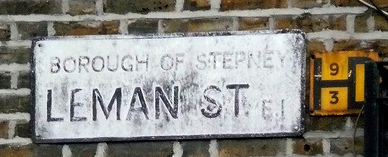 Leman Street (formerly Red Lion Street) - see also 1921 Street Directory
Leman Street (formerly Red Lion Street) - see also 1921 Street Directory
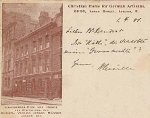
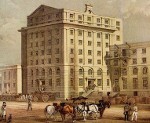 'Leman'
is an old term for a mistress or lover, which may be the
reason why some local people
pronounce it 'Lemon', and it is so spelt on some old maps, although as explained here the name comes from Sir John Leman. In
1831 the Garrick Theatre was built in the street - see here for details of earlier local theatres - which was demolished in 1891, and the police station (previously a few doors away) was rebuilt on the site. Right is a 'fireproof' sugar refinery of 1850 - see here for
the background to this. The
continued German presence in the vicinity - with churches in Alie Street and Hooper Square - is shown by the two
early 20th century postcards, the first of a 'Christian Home for German
Artisans' at
88-90 (later a German YMCA), the second of a private hotel at 114. The
mix of domestic and industrial premises continued apace, and is
explored in more detail here (in relation to the 1921 street directory).
'Leman'
is an old term for a mistress or lover, which may be the
reason why some local people
pronounce it 'Lemon', and it is so spelt on some old maps, although as explained here the name comes from Sir John Leman. In
1831 the Garrick Theatre was built in the street - see here for details of earlier local theatres - which was demolished in 1891, and the police station (previously a few doors away) was rebuilt on the site. Right is a 'fireproof' sugar refinery of 1850 - see here for
the background to this. The
continued German presence in the vicinity - with churches in Alie Street and Hooper Square - is shown by the two
early 20th century postcards, the first of a 'Christian Home for German
Artisans' at
88-90 (later a German YMCA), the second of a private hotel at 114. The
mix of domestic and industrial premises continued apace, and is
explored in more detail here (in relation to the 1921 street directory).  Up
to 1892,13 Hooper Square, off Leman Street, was the base of a firm of
bookbinders, Flude & Skelt,
until 1878 a partnership between James
William Flude, Joseph Birch and George Skelt in Great Prescot Street.
The Skelt family, originally local shoemakers, were prominent in the
printing of toy theatre sheets - left.
Up
to 1892,13 Hooper Square, off Leman Street, was the base of a firm of
bookbinders, Flude & Skelt,
until 1878 a partnership between James
William Flude, Joseph Birch and George Skelt in Great Prescot Street.
The Skelt family, originally local shoemakers, were prominent in the
printing of toy theatre sheets - left.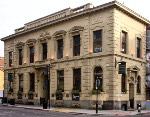 The Eastern
Dispensary
was set up in Great Alie Street in 1782 by a group of doctors (including the Quaker physician
and anti-slavery campaigner Thomas Knowles, who died in 1786 from a
fever caught from a patient), with the
Duke of
Wellington as President. It moved to new
premises
in Leman Street [now 19A] in 1858 [right]. It
closed in 1940 because of wartime
difficulties, and in 1944 the building was leased to the Jewish
Hospital Committee; the Charity Commission refused transfer to the
London Hospital, so assets were transferred to the Marie Celeste
Samaritan Society in 1952. Since 1998 the building has been a pub and
dining room. A 1787 booklet about the Dispensary sold a few years ago for
£1350!
The Eastern
Dispensary
was set up in Great Alie Street in 1782 by a group of doctors (including the Quaker physician
and anti-slavery campaigner Thomas Knowles, who died in 1786 from a
fever caught from a patient), with the
Duke of
Wellington as President. It moved to new
premises
in Leman Street [now 19A] in 1858 [right]. It
closed in 1940 because of wartime
difficulties, and in 1944 the building was leased to the Jewish
Hospital Committee; the Charity Commission refused transfer to the
London Hospital, so assets were transferred to the Marie Celeste
Samaritan Society in 1952. Since 1998 the building has been a pub and
dining room. A 1787 booklet about the Dispensary sold a few years ago for
£1350!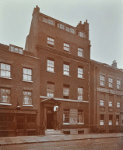
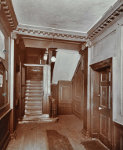
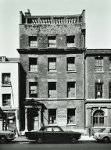
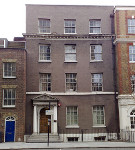
 There are several listed buildings in the street. Left are five images of no.66,
a brown brick 4-storey house of about 1760, with attic added later, at
various periods of its existence:
There are several listed buildings in the street. Left are five images of no.66,
a brown brick 4-storey house of about 1760, with attic added later, at
various periods of its existence: 
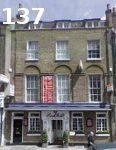 Two other Grade 2 listed buildings [right] are no.137 with a late 18th/early 19th century façade [at one time the manager's office of the London,Tilbury & Southend Railway's nearby goods depot, and now the Red Chilli curry club], and no.141 with vestiges of an early 18th century façade [which was a mosque for a time, and is now an Indian restaurant]; the Brown Bear was in between at no.139.
Two other Grade 2 listed buildings [right] are no.137 with a late 18th/early 19th century façade [at one time the manager's office of the London,Tilbury & Southend Railway's nearby goods depot, and now the Red Chilli curry club], and no.141 with vestiges of an early 18th century façade [which was a mosque for a time, and is now an Indian restaurant]; the Brown Bear was in between at no.139.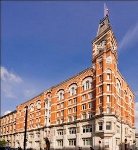
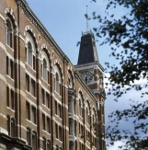

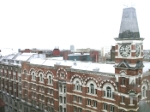 In
1887 the Co-operative Wholesale Society opened the grand headquarters
of its London operations on
the corner of Leman Street and Hooper Street [three views left], a seven-storey structure
in brick, granite and Portland stone incorporating a sugar warehouse
and a prominent clock tower, designed by J.F. Goodey of Colchester, a
CWS committee member about whom little is known. Right is the CWS wheatsheaf logo, Labor and wait, carved on the building. The wheatsheaf [like the bee, above] was a symbol of co-operation - one stalk cannot stand alone - and
is found in various forms on Co-op buildings up and down the land; the
American spelling 'labor' was deliberately used to show solidarity with those
fighting slavery in America, drawing on the final words of the poem 'A
Psalm of Life' by the American poet Henry Wadsworth Longfellow (1807-82): Let us, then, be up and doing, / With a heart for any fate; / Still achieving, still pursuing, / Learn to labor and wait. (The words also provided the chorus of a contemporary temperance song.)
In
1887 the Co-operative Wholesale Society opened the grand headquarters
of its London operations on
the corner of Leman Street and Hooper Street [three views left], a seven-storey structure
in brick, granite and Portland stone incorporating a sugar warehouse
and a prominent clock tower, designed by J.F. Goodey of Colchester, a
CWS committee member about whom little is known. Right is the CWS wheatsheaf logo, Labor and wait, carved on the building. The wheatsheaf [like the bee, above] was a symbol of co-operation - one stalk cannot stand alone - and
is found in various forms on Co-op buildings up and down the land; the
American spelling 'labor' was deliberately used to show solidarity with those
fighting slavery in America, drawing on the final words of the poem 'A
Psalm of Life' by the American poet Henry Wadsworth Longfellow (1807-82): Let us, then, be up and doing, / With a heart for any fate; / Still achieving, still pursuing, / Learn to labor and wait. (The words also provided the chorus of a contemporary temperance song.)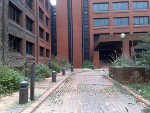

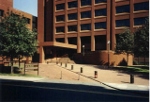

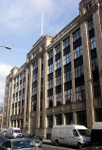
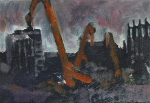
 The
large red-brick complex on the corner of Leman and Alie Streets was
developed in the 1970s, on the site of the engine sheds of the Southend Railway, as a computer, interbank cheque clearing and IT
development centre for National Westminster Bank,
with an extension added in the 1990s. The 'campus' also included
buildings at 75 [first right] and 135 Leman Street (Eastgate House, second right),
linked by a bridge; for a time it had its own pub, The Long Bar
(originally signed as 'Management Services Division'). NatWest was
taken over by the Royal Bank of Scotland in 2000 and the computer
mainframes went elsewhere.
The
large red-brick complex on the corner of Leman and Alie Streets was
developed in the 1970s, on the site of the engine sheds of the Southend Railway, as a computer, interbank cheque clearing and IT
development centre for National Westminster Bank,
with an extension added in the 1990s. The 'campus' also included
buildings at 75 [first right] and 135 Leman Street (Eastgate House, second right),
linked by a bridge; for a time it had its own pub, The Long Bar
(originally signed as 'Management Services Division'). NatWest was
taken over by the Royal Bank of Scotland in 2000 and the computer
mainframes went elsewhere. 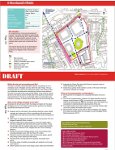
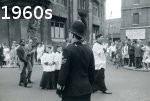

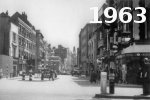
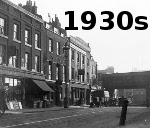 Demolition and re-development of the site
began in 2006 to create Berkeley Homes' City Quarter, and is ongoing: here are visualisations of the project. The painting of the demolition [above] is © Joanna Moore, 'The Town Mouse'. The site is one of Tower Hamlet's strategic allocations - left is the draft development plan (under the Local Development Framework) - CAB 051/112. Right
is Leman Street in the 1930s (looking south); in 1963, from the top by
Aldgate East station; the junction of Leman and Cable Streets some
years later; and, at the other end of the street, a Roman Catholic procession in the 1960s; see here for a link to a site with many other historical pictures of Roman Catholic events in the area.
Demolition and re-development of the site
began in 2006 to create Berkeley Homes' City Quarter, and is ongoing: here are visualisations of the project. The painting of the demolition [above] is © Joanna Moore, 'The Town Mouse'. The site is one of Tower Hamlet's strategic allocations - left is the draft development plan (under the Local Development Framework) - CAB 051/112. Right
is Leman Street in the 1930s (looking south); in 1963, from the top by
Aldgate East station; the junction of Leman and Cable Streets some
years later; and, at the other end of the street, a Roman Catholic procession in the 1960s; see here for a link to a site with many other historical pictures of Roman Catholic events in the area.
 Rupert & Lambeth Streets
Rupert & Lambeth StreetsDr.
Mayersbach, near Schweinfurth, in Germany ... came to London in
November, 1773; and from his subsequent success, he must have possessed
strong radical powers. Every other scheme that was suggested to his
inventive mind having failed, he offered himself to Angelo, who then
kept a riding school, but was not accepted, as his diminutive size
rendered him unsuitable for an equestrian posture-master. About this
period (1773) he became acquainted by an introductory letter from Mr.
Bresener, his brother-in-law, with his countryman, Dr. Griffenberg,
before his reputation was totally blasted by his voluptuous services to
Lord Baltimore; and it was agreed between them, that Griffenberg should
initiate Mayersbach into his urinary deceptions, for which a share of
the profits should be given given to the tutor, and which the great
success of that pupil was enabled amply to confer; but which was
probably withdrawn when Mayersbach became himself a professed adept; at
least, so I was informed by Griffenberg and his wife: part of the
engagement, indeed, extended to the latter, provided she should survive
her husband, which really happened. The agreement, so far as it
respected the widow, is literally translated from the original:
At the time that Dr Mayersbach first came under the tuition of Dr Griffenberg, he did not know one article of medicine, nor the treatment of one disease, when he published the following quack bill:
The two first patients he had were, one with the itch, and the other with a cough, and he was obliged to place them in another room, till he could receive a message from his master how to proceed. It would have hence been a remuneration which gratitude demanded, independently of written documents, to have relieved the widow; which, however, he absolutely refused, at a time when it was said that his income was at least five thousand pounds a year. Let it however be recorded to Dr. Mayersbach's honour, that in 1773, when lie lived in Rupert-street, Goodman's Fields, his wife, after a tedious illness, which proved fatal, had been attended by Johan Toennius, apothecary in Mansell-street; and on application to Mayersbach in 1776, he faithfully discharged the expence of attendance which her illness had occasioned. As Mayersbach was totally ignorant of medicines, certain pills, powders, and drops, with directions to give them, under certain circumstances, were sent to him; and these he administered discretionally. As he got a little more fledged, he attempted a loftier flight, and even ventured to handle edged tools; but in consequence of their indiscriminate use, many serious effects succeeded, which were formally communicated to a board of the Royal College of Physicians, when it was archly observed by one of the board, that the charges merited investigation in the criminal courts of law; and thus the business ended with a laugh at the gentleman who presented these charges, for his ignorance in imagining that the College of Physicians ever did a wise act; or, in any instance, ever promoted medical science science. Mayersbach's reputation continued for some months in the most elevated degree. As a water doctor in the metropolis must be supposed to know more than the water doctors in the country, the devotees to deception flocked to town, or sent up their vials by the stages, and the urinary traffic of the country was transferred to London; and thus the German impostor, who, a few months before could not cure the itch, monopolized the most lucrative professional business in Europe. Among his patients he could claim a Harrington, a Hawke, and even a Garrick .... |
 In 1777 the Monthly Review, or Literary Journal
(vol 55) told Dr Toennius' side of the story - how Mayerbach was
lodging with a shoemaker, pleading poverty, claiming to be seeking
employment with a starch-maker, and declaring himself to be totally unacquainted with medicine - so he took no fee until he learnt of his reputation. The report - right - also claims that he treated animals, declaring in one case, after inspecting a cow's urine, that the party had been too free with the ladies of the town. Mayersbach quit London after exposure, but returned within a year and was again successful; he died soon afterwards.
In 1777 the Monthly Review, or Literary Journal
(vol 55) told Dr Toennius' side of the story - how Mayerbach was
lodging with a shoemaker, pleading poverty, claiming to be seeking
employment with a starch-maker, and declaring himself to be totally unacquainted with medicine - so he took no fee until he learnt of his reputation. The report - right - also claims that he treated animals, declaring in one case, after inspecting a cow's urine, that the party had been too free with the ladies of the town. Mayersbach quit London after exposure, but returned within a year and was again successful; he died soon afterwards.
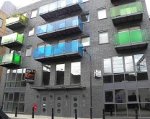

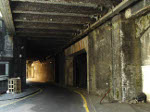 is
south of Prescot Street, running alongside and underneath the railway
from Leman Street to Goodman's Yard; it was included in Charles Booth's 1888 survey. Today at its western end is a Travelodge, and Barneys
Seafood, the last remaining fish wholesaler with roots near
Billingsgate Market, whose factory shop sells jellied eels and other
traditional East End fare (lots of good recipes on their site). The former Swallows Gardens (a 'Ripper site') runs through their premises [right].
At the eastern end of the street is
contemporary housing development - example far right. It is hoped that development proposals for the Royal Mint Street site will include community facilities in the railway arches and basements, accessed from Chamber Street.
is
south of Prescot Street, running alongside and underneath the railway
from Leman Street to Goodman's Yard; it was included in Charles Booth's 1888 survey. Today at its western end is a Travelodge, and Barneys
Seafood, the last remaining fish wholesaler with roots near
Billingsgate Market, whose factory shop sells jellied eels and other
traditional East End fare (lots of good recipes on their site). The former Swallows Gardens (a 'Ripper site') runs through their premises [right].
At the eastern end of the street is
contemporary housing development - example far right. It is hoped that development proposals for the Royal Mint Street site will include community facilities in the railway arches and basements, accessed from Chamber Street.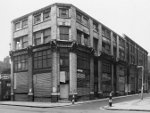

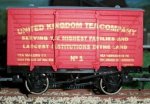
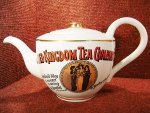
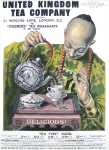
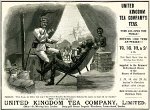 On
the corner of Leman and Chamber Streets were the Imperial Warehouses [left in 1970, with its contemporary replacement, an office block at no.120],
base for various businesses over the years. In the latter years of the 19th century it housed the
duty-paid stores of the United Kingdom Tea Company, whose head office
was at 21 Mincing Lane. Their imaginative advertisements of the 1890s have
been
much-studied for their semiotic significance: they include Samuel Pepys
(who wrote in 1660 I did send for a cup of Tea [a China drink]),
Britannia, and [right] Dr
Livingstone, and a ponytailed Mandarin, all drinking tea, showing it
both as a patriotically English and an exotic activity. A teapot
bearing the company logo, and a model railway wagon, are also shown. In 1889 a clerk, who had a key to the warehouse, was convicted of
stealing 110lb. of tea over a 3-week period, to which he claimed he was
entitled in lieu of unpaid wages. in 1898 William Dunham Ltd, operating from these premises, went bust. In the 20th century, British American Belts Ltd occupied 8-12 Imperial Warehouses; latterly described as plastic goods manufacturers, the company was dissolved in 1969. (The freehold of nos.2,4 and 6 was registered by D. and A. Marks, of 60 Leman
Street, in 1952.)
On
the corner of Leman and Chamber Streets were the Imperial Warehouses [left in 1970, with its contemporary replacement, an office block at no.120],
base for various businesses over the years. In the latter years of the 19th century it housed the
duty-paid stores of the United Kingdom Tea Company, whose head office
was at 21 Mincing Lane. Their imaginative advertisements of the 1890s have
been
much-studied for their semiotic significance: they include Samuel Pepys
(who wrote in 1660 I did send for a cup of Tea [a China drink]),
Britannia, and [right] Dr
Livingstone, and a ponytailed Mandarin, all drinking tea, showing it
both as a patriotically English and an exotic activity. A teapot
bearing the company logo, and a model railway wagon, are also shown. In 1889 a clerk, who had a key to the warehouse, was convicted of
stealing 110lb. of tea over a 3-week period, to which he claimed he was
entitled in lieu of unpaid wages. in 1898 William Dunham Ltd, operating from these premises, went bust. In the 20th century, British American Belts Ltd occupied 8-12 Imperial Warehouses; latterly described as plastic goods manufacturers, the company was dissolved in 1969. (The freehold of nos.2,4 and 6 was registered by D. and A. Marks, of 60 Leman
Street, in 1952.)